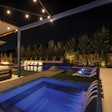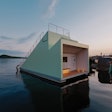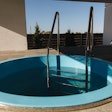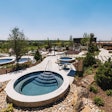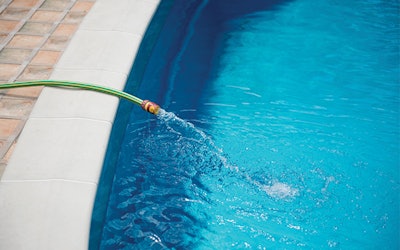
|
NOTE: The RWQC collaborated with members from the American Water Works Association (AWWA) Disinfection Committee to produce this issue of Tech Notes, including the following individuals: Dr. Vadim Malkov, Hack Company Sarah Richardson, San Jose Water Company David G. Wahman, Research Environmental Engineer, EPA National Risk Management Research Laboratory, Water Systems Division Richard Weisman, Environmental Engineer at U.S. EPA |
Most pool and spa operators understand that the primary source of "combined chlorine" in the water results from the reaction of chlorine sanitizer with bather perspiration and waste. However, another potential source is chloraminated tap water, which may be used for fill and makeup water. When pool and hot tub operators use tap water to fill, they may inadvertently be adding considerable amounts of combined chlorine.
Municipal drinking water is commonly chloraminated to create a longer-lasting disinfectant residual and to limit the formation of certain EPA-regulated chlorination disinfection byproducts. Both chlorine and small amounts of ammonia are added to the water separately. They react together to form chloramines, which are detected as combined chlorine in pool water.
RELATED: Source Water and its Effects on Pool and Spa Maintenance
This process produces monochloramine, which is less of an irritant than other common chloramines, such as dichloramine and trichloramine. Chloramine disinfection with monochloramine is used in both small and large water treatment plants and usually controlled by measuring total chlorine residual concentration. While use of monochloramine works well for drinking water, it does not work well in pool and hot tub water.
USE IN POOLS AND HOT TUBS
Fresh Fills. It is best to avoid using chloraminated tap water for fresh fills of pools and hot tubs. In all cases, verify the origin of your source water (refer to the RWQC Source Water Tech Notes or Fact Sheet) and test your fill water for combined chlorines. If combined chlorine is present, take the following remedial steps after filling the pool or hot tub:
1. If necessary, adjust the pH to 7.4-7.6.
2. Oxidize the pool/hot tub using a non-stabilized chlorine oxidizer to achieve an acceptable concentration of combined chlorines.
Makeup Water. Makeup water is water that is added to a pool or hot tub to replace water that has been lost from evaporation, splash out or backwashing. The volume of makeup water is small compared to the total volume of the pool or hot tub, so when chloraminated makeup water is added to a pool, the impact is much less than when chloraminated water is used to fill a pool.
RELATED: Chloramines In Source Water
The impact may be important to operators of pools with high bather loads, where compliance with the maximum combined chlorine concentration is difficult. After adding makeup water, the pool water should be tested to determine the concentration of chloramines. If the combined chlorine concentration is unacceptable, it can be reduced by adjusting the pH to 7.4-7.6 and oxidizing with nonstabilized chlorine. After the desired combined chlorine concentration has been attained, balance the pH and alkalinity.
TEST INTERFERENCE
Chloraminated water may present a problem with DPD testing of free chlorine concentration when combined chlorine is above 1–2 ppm. An interference will occur in the DPD test for free chlorine if the reading is not taken within 30 seconds. This will result in high free chlorine readings. A separate total chlorine test would be required after the free chlorine test.
Chloramination: A Few FactsChloramination is a process that adds free chlorine (usually chlorine gas, sodium hypochlorite or calcium hypochlorite) and ammonia to water to form chloramines. The process is often used by water treatment authorities to treat drinking water. If you have any questions as to whether or not your water is chloraminated, contact your local water authority or visit the U.S. Environmental Protection Agency website.
|
This article originally appeared in the November 2020 issue of AQUA Magazine, a top resource for retailers, builders and service pros in the pool and spa industry. Subscriptions to the print magazine are free to all industry professionals. Click here to subscribe.

































